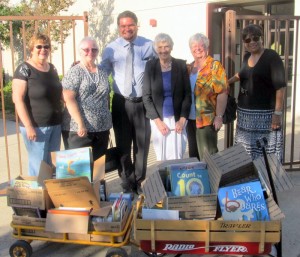![0000019134-tmlwom129-004[1]](https://riverside-ca.aauw.net/files/2013/08/0000019134-tmlwom129-0041-300x226.jpg) Ninety three years ago, On August 24, 1920, the 19th amendment was ratified giving women the right to vote. Although the amendment had passed comfortably through Congress with the requisite two-thirds majority in 1919 (the vote was 304–89 in the House of Representatives on May 21, 1919, and 56–25 in the Senate on June 4, 1919), there was considerable doubt as to whether or not it would be able to garner the 36 states necessary to secure ratification. Legislators in many Southern states were opposed to the amendment (it was rejected in Georgia, Alabama, South Carolina, Virginia, Maryland, Mississippi, and Louisiana), and its fate appeared to hinge on Tennessee. As Cheryl Hiers writes in “War of the Roses,” when suffragists counted its supporters in Nashville when the Tennessee legislature was to cast its votes on August 18, 1919, they
Ninety three years ago, On August 24, 1920, the 19th amendment was ratified giving women the right to vote. Although the amendment had passed comfortably through Congress with the requisite two-thirds majority in 1919 (the vote was 304–89 in the House of Representatives on May 21, 1919, and 56–25 in the Senate on June 4, 1919), there was considerable doubt as to whether or not it would be able to garner the 36 states necessary to secure ratification. Legislators in many Southern states were opposed to the amendment (it was rejected in Georgia, Alabama, South Carolina, Virginia, Maryland, Mississippi, and Louisiana), and its fate appeared to hinge on Tennessee. As Cheryl Hiers writes in “War of the Roses,” when suffragists counted its supporters in Nashville when the Tennessee legislature was to cast its votes on August 18, 1919, they
“knew they were in trouble. By the roses [suffragists wore yellow roses while anti-suffragists donned red ones], it appeared the amendment would be defeated 47 for and 49 against. In the first roll call, however, Rep. Banks Turner came over to the Suffragist’s side and the vote was deadlocked at 48 for and 48 against. The second roll was taken and the vote remained 48 to 48.
With wilted collars and frayed nerves, the legislators squared off for the third roll call. A blatant red rose on his breast, Harry Burn–the youngest member of the legislature–suddenly broke the deadlock. Despite his red rose, he voted in favor of the bill and the house erupted into pandemonium. With his “yea,” Burn had delivered universal suffrage to all American women. The outraged opponents to the bill began chasing Representative Burn around the room. In order to escape the angry mob, Burn climbed out one of the third-floor windows of the Capitol. Making his way along a ledge, he was able to save himself by hiding in the Capitol attic.
When tempers had cooled, Burn was asked to explain the red rose on his lapel and his “yellow-rose” vote. He responded that while it was true he was wearing a red rose, what people couldn’t see was that his breast pocket contained a telegram from his mother in East Tennessee. She urged him to do the right thing and vote in favor of the amendment.”
Thus, it was a mother’s urging that ultimately secured the Nineteenth Amendment in 1919. Other states would go on to ratify the Nineteenth Amendment, though Virginia and Alabama wouldn’t do so until the 1950s, Florida would hold out until 1969, Georgia and Louisiana would go on to ratify it in 1970, and Mississippi would wait until 1984 to formally ratify the amendment.
On Monday, August 26, we’ll celebrate another Women’s Equality Day, the day that marks the anniversary of when the 19th Amendment was ratified. It’s a day to stand up with our sisters to recognize the hard work of the women and men who led the successful suffrage movement 93 years ago. Unfortunately, celebrating our right to vote isn’t enough. We still have a lot to do to keep the polls accessible to everyone and reach equality for women and girls, so this Women’s Equality Day, we ask you to educate others and join the fight!




![starbucks_coffee_1[1]](https://riverside-ca.aauw.net/files/2013/08/starbucks_coffee_11-150x150.png)